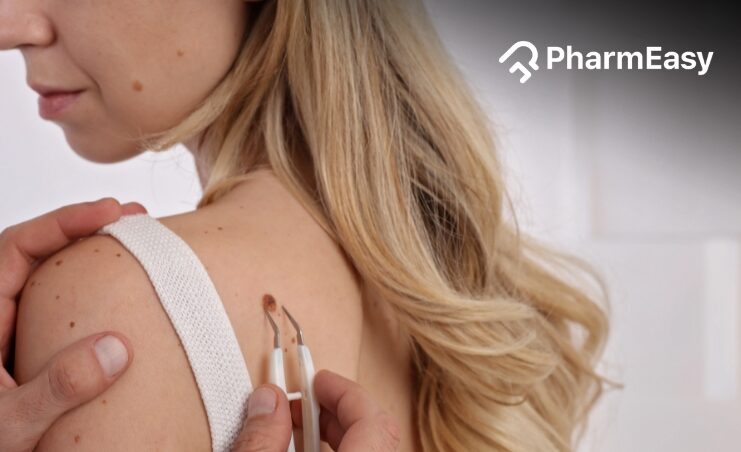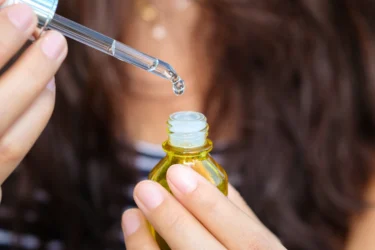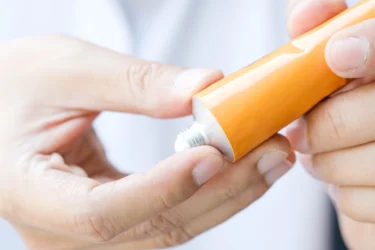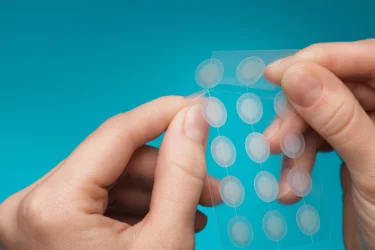How to Get Rid of Skin Tags: A Step-by-Step Guide Based on Science
By Dr. Shubham Pandey +2 more

Get,

to manage your symptom
Get your,


4 Cr+ families
benefitted

OTP sent to 9988776655



You’ve successfully subscribed to receive
doctor-approved tips on
Whatsapp

Get ready to feel your best.

Hi There,
Download the PharmEasy App now!!


Register to Avail the Offer
Send OTPBy continuing, you agree with our Privacy Policy and Terms and Conditions

Hi There,
Sign up on PharmEasy now!!
Trusted by 4 crore+ families

OTP sent to 9988776655



You have unlocked 25% off on medicines




Code: NU25

Comments


Leave your comment here
By Dr. Shubham Pandey +2 more
Table of Contents
Skin tags, while not dangerous, can still annoy you and affect how you look. They often occur when your skin rubs against skin or clothing1. Even though they are harmless, many people want to remove them for aesthetic reasons or because they can get irritated.
This article will cover all you need to know about skin tags. You’ll learn what they are, why they appear, and the risk factors. We’ll discuss about home remedies and other products you may buy to remove skin tags, coupled with safety measures to follow. You’ll also learn when to reach out to a doctor and explore professional skin tag removal options. Lastly, we’ll go over how to care for your skin after the skin tags have been removed and steps to avoid future formation of skin tags.

Did you know?
Skin tags are harmless growths that usually don’t cause health issues, but can still bother you. Before starting any removal process, it’s key to understand what skin tags are and correctly identify them.
Skin tags, also called acrochordons, are small, soft lumps of skin that arise when skin rubs together. Usually, they are between 2 and 5 millimeters in size but can grow much larger. Skin tags can appear anywhere on the body but are often found near skin folds, like the neck, underarms, torso, eyelids, and inner thighs. They are often the same colour as your skin or darker, and usually don’t hurt unless irritated2.
We don’t know the exact cause of skin tags yet. Still, several known factors can increase your chances of getting these skin growths, which are listed below.
Before taking a swing at home remedies, be sure that it’s a skin tag and not something more serious. Ask a health professional if unsure. We’re about to list a few common home remedies for skin tags, how to use them, and the safety measures to bear in mind.
Safety Considerations: Keep in mind that removing skin tags yourself comes with risks like infection, bleeding, and scarring. If you feel discomfort in any way during or after applying home remedies, get in touch with a healthcare professional immediately. It’s vital to follow all guidelines and to only use clean, sanitized tools when trying these remedies.

This oil is known for its antiviral and antifungal traits and may prove to be a useful home remedy3.
How to apply?
Precautions
Don’t use pure tea tree oil and test it on a small bit of your skin before using it on a skin tag to check for allergies this is known as a patch test. Stay away from the eye area with this oil.

This vinegar is known for its acidic nature, which some say may help skin tags to shrink and drop off4.
How to use?
Risks and precautions
Be careful with apple cider vinegar as it can irritate the skin or cause burns. Be sure not to put it near the eyes and look out for signs of skin reactions while using it.

Some think garlic’s anti-inflammation might make skin tags look better5.
Application and precautions
Note, the strong smell of garlic might put some people off. And be careful if you have sensitive skin, as garlic can cause irritation.

Vitamin E is known for its antioxidant traits, which may fend off wrinkles and keep skin healthy6. Rubbing liquid vitamin E onto a skin tag might make it fall off in a few days.
Usage and benefits
Ensure that you do not have an allergy to vitamin E before using it on your skin. Also, know that using vitamin E near the eyes can be irritating.

Some say banana peels have antioxidant traits, which might help dry out skin tags7.
How to use?
Benefits
Using banana peels to remove skin tags costs little and is not invasive. Still, there isn’t much scientific proof that it works. So, you’ll need a lot of patience with this method, as it may take some time before you see any results.
Recently I came across a study that suggested skin tags can sometimes indicate a higher risk of heart and blood vessel problems. This is because people with skin tags often have other health issues like being overweight, high cholesterol, high blood pressure, insulin resistance, and increased inflammation in their bodies11.
Dr. Siddharth Gupta, B.A.M.S, M.D (Ayu)
For those not into home remedies, there are many over-the-counter (OTC) products to help you remove skin tags. Remember though, it’s best to talk to a health professional if you doubt using OTC products.

These creams can be found in loads of stores but may work better for some than others. It’s key to buy a cream that won’t irritate your skin. Be wary of creams holding salicylic acid and tea tree oil, as these might cause your skin to get red.

Such kits, or cryotherapy kits, use deep cold to kill unwanted skin tissue. These kits can be found in most drugstores and need to be used carefully so as not to hurt the surrounding skin. Always keep to the kit’s instructions and watch the skin area where you have applied the kit for bad reactions.

Skin tag removal bands, also known as ligation bands, work by cutting off the blood flow to the skin tag. This method takes time but might cause problems like infection, bleeding, and scarring. On the other hand, skin tag removal patches hold medicines that make the skin tag dry up and fall off. Results vary, and these patches could irritate the skin for some people.
Bands are wrapped around the base of the skin tag. This stops blood flow which kills the cells in the tag. The skin tag then dries up and falls off. Skin tag removal patches usually have medicines that slowly break down the surrounding tissue. This leads to the skin tag falling off.
Removal bands and patches may work, but DIY removal has risks. Be sure to keep everything clean and follow all instructions to lessen the risk of infection, bleeding, and scarring. Also, monitor the affected area for any unusual signs. If you have any bad reactions, talk to a health professional straight away.
To my knowledge, skin tags are way more common than you think. It has an estimated occurrence ranging from 50 to 60% among the general population12.
Dr. Rajeev Singh, BAMS
While home remedies and OTC products may help some people, there are times when it’s better to get help from a professional. Here are some such situations, described below.
Make sure to see a doctor if the following happens.
It’s crucial for a health professional to check and confirm that your skin growth is a harmless skin tag and not a more serious skin issue.
There are some situations when home remedies and OTC products are a no-go. Ask for professional help to remove a skin tag if:
It’s not widely known that skin tags, typically associated with humans, can also manifest on our furry friends, such as dogs. While common in older canines, these skin tags can present in various forms and are generally harmless. Yet, if you observe any alterations in their size, shape, or color, or if they cause discomfort to your pet, it’s advisable to seek evaluation from a veterinarian promptly.
Dr. Smita Barode, B.A.M.S, M.S.
If home remedies and OTC products don’t suit you, or if you want a quick fix, professional skin tag removal could be best. Health professionals offer different surgical methods to remove skin tags safely and swiftly.
After removing a skin tag professionally, you need to care for the area well to promote healing and stop infection.
If you understand why skin tags appear, you may try steps to lower their chances of forming.
Skin tags are harmless but sometimes vexing lumps that crop up at several body parts. If you decide that it’s needed, there are many home remedies, OTC products, and professional methods available to remove them. Don’t forget to be careful and follow safety measures when trying home remedies. For the best results and to keep risks low, consider asking a healthcare professional for skin tag removal. Aftercare is crucial to avoid infection and healing well. Knowing potential causes and risk factors for skin tags may help you take steps toward stopping them from forming.
Also Read: Healthy Skin Tips: Research-Backed Strategies for a Glowing Complexion
You may try several methods to remove skin tags at home, like using tea tree oil or apple cider vinegar. But these come with risks, including infection, bleeding, and scarring. It’s safer to consult a healthcare professional for the correct skin tag test and removal.
Keeping a healthy weight, managing diabetes, and sorting any hormonal imbalances may help lower the chance of skin tags forming. But, as things like genetics and infections can also lead to skin tags, completely avoiding them may not be possible.
Home removal methods come with risks like infection, bleeding, and scarring. Poor technique or unclean equipment increases these risks. Seeing a healthcare professional ensures proper removal and lowers these risks.
Once a skin tag is fully removed, it won’t grow back. But new skin tags may arise in the same spot or nearby.
Health insurance plans typically do not cover skin tag removal as it’s often looked at as a beauty-enhancing procedure. However, if a skin tag harms your physical or mental health, your insurance plan may provide coverage.
1. Pandey A, Sonthalia S. Skin Tags. [Updated 2023 Jul 31]. In: StatPearls [Internet]. Treasure Island (FL): StatPearls Publishing; 2025 Jan-. Available from: https://www.ncbi.nlm.nih.gov/books/NBK547724/
2. Healthdirect Australia. Skin tags (acrochordons) [Internet]. Melbourne: Healthdirect Australia; 2025 Mar [cited 2025 Nov 13]. Available from: https://www.healthdirect.gov.au/skin-tags
3. Carson CF, Hammer KA, Riley TV. Melaleuca alternifolia (Tea Tree) oil: a review of antimicrobial and other medicinal properties. Clin Microbiol Rev. 2006 Jan;19(1):50-62. doi: 10.1128/CMR.19.1.50-62.2006. PMID: 16418522; PMCID: PMC1360273. Available from: https://pmc.ncbi.nlm.nih.gov/articles/PMC1360273/
4. Luu LA, Flowers RH, Gao Y, Wu M, Gasperino S, Kellams AL, Preston DC, Zlotoff BJ, Wisniewski JA, Zeichner SL. Apple cider vinegar soaks do not alter the skin bacterial microbiome in atopic dermatitis. PLoS One. 2021 Jun 2;16(6):e0252272. doi: 10.1371/journal.pone.0252272. PMID: 34077434; PMCID: PMC8172074. Available from: https://pubmed.ncbi.nlm.nih.gov/34077434/
5. Pazyar N, Feily A. Garlic in dermatology. Dermatol Reports. 2011 Apr 28;3(1):e4. doi: 10.4081/dr.2011.e4. PMID: 25386259; PMCID: PMC4211483. Available from: https://pmc.ncbi.nlm.nih.gov/articles/PMC4211483/
6. Keen MA, Hassan I. Vitamin E in dermatology. Indian Dermatol Online J. 2016 Jul-Aug;7(4):311-5. doi: 10.4103/2229-5178.185494. PMID: 27559512; PMCID: PMC4976416. Available from: https://pmc.ncbi.nlm.nih.gov/articles/PMC4976416/
7. Hikal WM, Said-Al Ahl HAH, Bratovcic A, Tkachenko KG, Sharifi-Rad J, Kačániová M, Elhourri M, Atanassova M. Banana Peels: A Waste Treasure for Human Being. Evid Based Complement Alternat Med. 2022 May 13;2022:7616452. doi: 10.1155/2022/7616452. PMID: 35600962; PMCID: PMC9122687. Available from: https://pmc.ncbi.nlm.nih.gov/articles/PMC9122687/
8. Tribonias G, Papaefthymiou A, Zormpas P, Seewald S, Zachou M, Barbaro F, Kahaleh M, Andrisani G, Elkholy S, El-Sherbiny M, Komeda Y, Yarlagadda R, Tziatzios G, Essam K, Haggag H, Paspatis G, Mavrogenis G. Endoscopic Local Excision (ELE) with Knife-Assisted Resection (KAR) Techniques Followed by Adjuvant Radiotherapy and/or Chemotherapy for Invasive (T1bsm2,3/T2) Early Rectal Cancer: A Multicenter Retrospective Cohort. J Clin Med. 2024 Nov 18;13(22):6951. doi: 10.3390/jcm13226951. PMID: 39598095; PMCID: PMC11594537. Available from: https://pubmed.ncbi.nlm.nih.gov/39598095/
9. Dyck PKV, Hockaden N, Nelson EC, Koch AR, Hester KL, Pillai N, Coffing GC, Burns AR, Lafontant PJ. Cauterization as a Simple Method for Regeneration Studies in the Zebrafish Heart. J Cardiovasc Dev Dis. 2020 Oct 3;7(4):41. doi: 10.3390/jcdd7040041. PMID: 33022937; PMCID: PMC7711552. Available from: https://pubmed.ncbi.nlm.nih.gov/33022937/
10. Prohaska J, Jan AH. Cryotherapy in Dermatology. [Updated 2023 Sep 15]. In: StatPearls [Internet]. Treasure Island (FL): StatPearls Publishing; 2025 Jan-. Available from: https://www.ncbi.nlm.nih.gov/books/NBK482319/
11. Sari R, Akman A, Alpsoy E, Balci MK. The metabolic profile in patients with skin tags. Clin Exp Med. 2010;10:193‑7. doi:10.1007/s10238-009-0086-5. Available from: https://link.springer.com/article/10.1007/s10238-009-0086-5
12. Pandey A, Sonthalia S. Skin Tags. [Updated 2023 Jul 31]. In: StatPearls [Internet]. Treasure Island (FL): StatPearls Publishing; 2025 Jan-. Available from: https://www.ncbi.nlm.nih.gov/books/NBK547724/
Disclaimer: The information provided here is for educational/awareness purposes only and is not intended to be a substitute for medical treatment by a healthcare professional and should not be relied upon to diagnose or treat any medical condition. The reader should consult a registered medical practitioner to determine the appropriateness of the information and before consuming any medication. PharmEasy does not provide any guarantee or warranty (express or implied) regarding the accuracy, adequacy, completeness, legality, reliability or usefulness of the information; and disclaims any liability arising thereof.
Links and product recommendations in the information provided here are advertisements of third-party products available on the website. PharmEasy does not make any representation on the accuracy or suitability of such products/services. Advertisements do not influence the editorial decisions or content. The information in this blog is subject to change without notice. The authors and administrators reserve the right to modify, add, or remove content without notification. It is your responsibility to review this disclaimer regularly for any changes.
Comments

Leave your comment...

View all comments(1)
You may also like
Skin tag remove how much cast